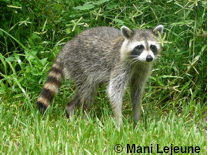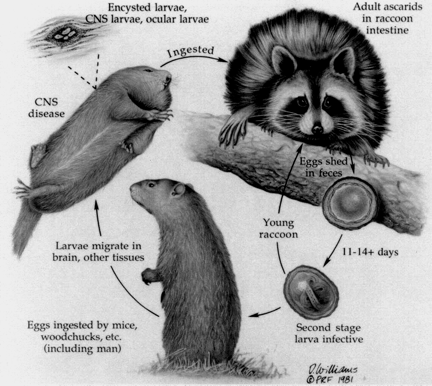Baylisascaris procyonis
Contributor: Manigandan Lejeune and James Wasmuth
Biology: A common parasitic roundworm of raccoons, recognized for fatal or severe neurological disease in humans and dogs caused by its migrating larvae.

Figure 1. Raccoons are the primary hosts for Baylisascaris procyonis.
Life cycle: Raccoons are the primary host for B. procyonis, in which the parasite can establish with high prevalence and tremendous egg production. Many species of rodents and birds are intermediate hosts (Larvae encyst in brain and other tissues and thus parasite rarely become patent). Infected raccoon may shed as many as 45 million eggs per day. Upon ingestion of infective eggs (by young raccoons) or encysted larvae in the intermediate host (by adult raccoons), larvae develop to patency in the small intestine of the primary host. In contrast, the larvae penetrate intestinal wall, migrate and encyst in various tissues, including the central nervous system (CNS) of the intermediate host. Humans act as intermediate host for B. procyonis.

Figure 2. Life cycle of Baylisascaris procyonis (Source: Strausbaugh LJ et al. Clin Infect Dis. 2004).
Transmission: Ingestion of embryonated eggs or infected intermediate host. Humans get infected through ingestion of infective eggs.

Figure 3. Egg of Baylisascaris procyonis.
Prevalence: Widespread geographic distribution (Many North American and European countries and in Japan). In North America, it is more common in eastern parts of Canada, Midwestern, northeastern and along the west coast of United States. Prevalences in raccoons reach up to 80% in endemic areas.
Susceptible populations: More than 90 species of mammals and birds are infected. Humans, particularly young children who are likely to ingest dirt, are susceptible.
Symptoms: In primary host: Mostly asymptomatic. Unthriftiness, occasionally intestinal impaction. In intermediate host: Depression, lethargy, agitation, tremors, head and/or body tilt, circling, lateral recumbency, coma. In humans: Fatal or severe sequelae involving CNS or eyes.
Treatment: Primary host: General deworming. Intermediate host including humans: No highly effective treatment exists. Albendazole and dieithylcarbamezine may be effective. Laser photocoagulation has been successful for treating eye infections.
Control measures: Relocate infected raccoons. Keeping raccoons as pet should be discouraged. Avoid contact with raccoon latrines. Disinfect premises frequented by raccoons. Disinfectants include 50/50 mixture of xylene/absolute alcohol, boiling Lysol or boiling water. Flaming an area is also effective. Public education about the health hazards associated with B. procyonis must be encouraged.

Figure 4. Contact with raccoon latrines can be a risk factor for Baylisascaris procyonis infection.